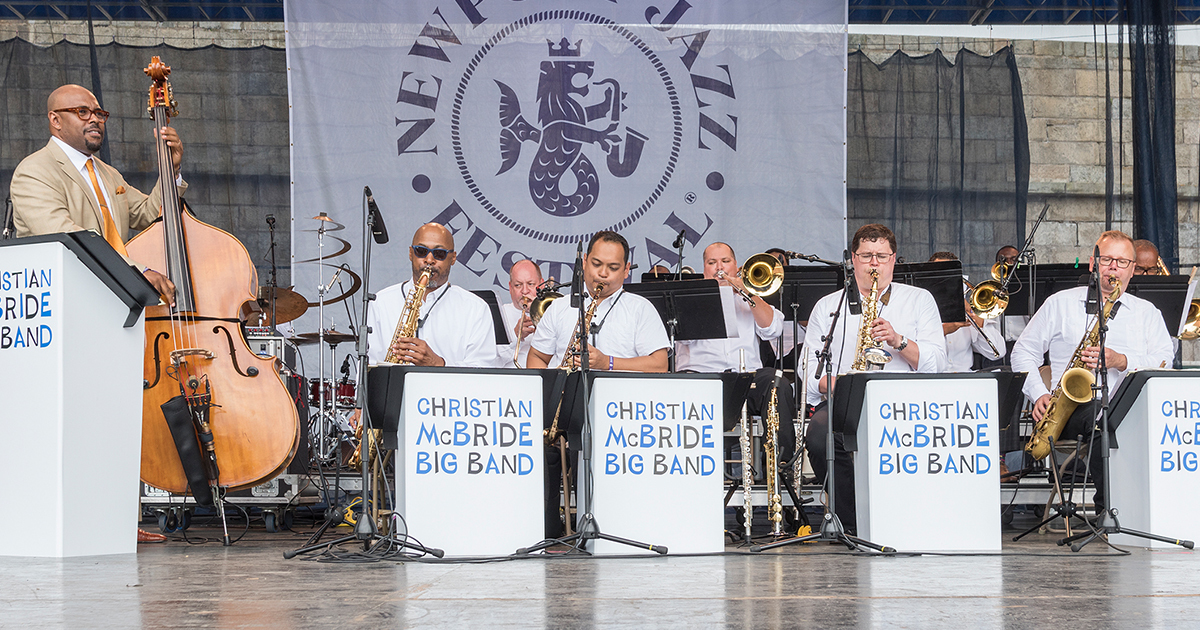5 Ways to Make Your Saxophone Section Sound Like Pros
by John Thomas
Date Posted: May 04, 2016

Photo: Yuki Tei with the Christian McBride Big Band
A great sounding saxophone section is integral to any big band. Each player should be individually working on tone, technique, style, and intonation, but getting all five players to think, work, and play as a unit is just as important. Here are some basic concepts that can help any section achieve a great sound:
1.
Listen to the Masters!
Knowing what a great section should sound like is the first step. Studying recordings of the masters is the best guide to interpreting the music. The prototype for the modern saxophone section is the Count Basie Band of the 1950s and 60’s. The album Basie Straight Ahead in particular, has some great examples of the section of that period, led by Marshall Royal. The next evolution is the Thad Jones/Mel Lewis Orchestra. A good track to listen to is Groove Merchant. Thad Jones writes great sax solis, and the one on “Groove Merchant” is killer. One exercise that I like to do with students is listen to the different versions that have been recorded over the years, beginning with Central Park North (Jerome Richardson lead), and ending up on Legacy, with Dick Oatts playing lead.
2.
Know your Horn’s Role!
Every horn in the section has a specific role to play. A saxophonist who tries to play the wrong role for their horn can upset the balance of the section. Here is a basic outline to follow:
Lead Alto
The lead alto player usually has the lead melodic line in the section, and dictates style, articulation and dynamics. Lead players should be the strongest player in the section. They should also be comfortable in a leadership role. They will lead sectionals and often serve as de facto conductor for the entire band, often cuing backgrounds and endings.
Second Alto
A second alto player’s job is to always support the lead player. When playing in unison, you must disappear into the lead alto’s sound. When playing harmony, you always play dynamically just under the lead alto. The biggest trap for a second player is overblowing the lead. If you do that, you push your lead player to play louder and louder, and this can force mistakes and bad intonation across the section.
First Tenor
The First or Lead tenor is one of the band’s chief soloists. Part of this gig is being ready to blow (improvise) on any tune at any time. As part of the sax section however, the lead tenor has to play a supportive role and blend in with the section. First tenors are often guilty of overblowing the lead, particularly after a burning solo.
Second Tenor
The second tenor player can really thicken up the sound of a sax section. Often given the “colorful” notes of the harmony, a second tenor part on its own usually sounds like nonsense, but added to the section makes for a really meaty sound. Usually voiced lower in the harmony, away from the lead alto, a second tenor can use a lot of sound without overblowing the lead.
Baritone
The bari is the foundation of the section. The bari often functions as an octave lower double for the lead alto, yet it is often paired with the bass bone. A good bari player will know when it’s time to dig in with the saxes, and when to listen back to the bones. A lead alto player with a great tone and a bari player with a big sound are the perfect bookends for the inner voices. The bari player is the only horn in the section who gets to play as loud as the lead player.
3.
Listen to Each Other!
Once you know your job, you have to constantly listen across the section to make sure that you are blending stylistically and dynamically. Listen to the lead player first, and the rest of the section after. A good rule of thumb: if you can’t hear the lead player, play softer!
4.
Hang Together/Play Together
A good section is a social and musical unit. The better you know and get along with each other personally, the better. The first step in building the unit is regular sectional rehearsals. Each sectional should begin with about five minutes of tuning. Other points to work on include articulation, dynamics, and phrasing. After the business of rehearsal is done, hang out!
One of the best sections I was in went for barbecue after every rehearsal. We got along great as people, and learned to respect each other individually, which ultimately brought us together as performers.
5.
Have the Right Gear!
For best results, have different setups for wind ensemble playing and jazz playing. Jazz has very different requirements than concert music in terms of volume, articulation and response. The same reeds that give you that nice dark covered sound for wind ensemble can make you sound stuffy in big band. Conversely, that metal tenor piece with a big wedge baffle might make it easier to play your Saturday night R+B gigs, but it sounds like a buzzsaw in the middle of a big band section. For jazz, you need a fast responding mouthpiece/reed/ligature combination that gives you enough volume to hang with the brass, but still maintains some warmth in your sound. Here are some basic suggestions:
Alto- Vandoren V16, A5-A7, Java Red or Green 2.5-3.5
Tenor-Vandoren V16 T6-T8 Hard Rubber,Java Red or Green 2.5-3.5, ZZ’s for a “woodier” tone.
Baritone– V16 Hard Rubber B5-B9, Java Red or Green 2.5-3.5
Vandoren M/O ligatures are a great option for fast response, as well as the Optimum ligaturewith the center ridge pressure plate.
Each one of these concepts are just a jumping off point. A section that covers all these bases is building a good foundation, and the rest are just details!